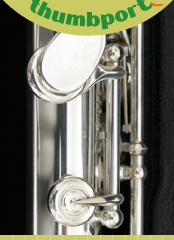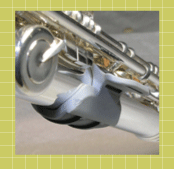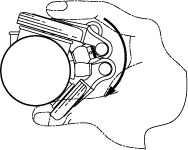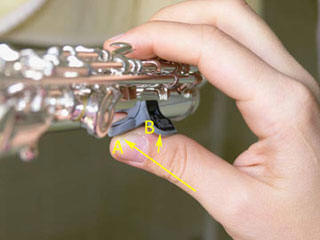

The Thumbport allows greater balance in holding the flute. It is comprised of a C-shaped shell and a thumb-like extension. The Thumbport helps the player to place the right thumb at an efficient spot and provides additional support.
Analysis
Mechanically, there are three factors associated with balancing a flute:
1. the mass (weight) of the flute,
2. horizontal rotation,
3. axial rotation.
The gravity center of a flute is located slightly to the right of the left index finger (see letter G in Illustration 1 below). When the knuckle of the left index finger takes up most of the weight of a flute at number 2, the small remaining weight is often assumed by the right thumb.
When playing a flute, the player pushes the embouchure plate against the chin (Ill. 1, number 1). With the left index finger both supporting and pushing, the flute might rotate clockwise without a counter force from the right hand.
Illustration 1

Additionally, the uneven weight of the flute mechanism contributes to another rolling tendency. This can be seen in Ill. 2. The flute rolls backwards toward the player.
Illustration 2

Because nine of our fingers are used to operate keys on a flute, only one, the right thumb, is left to decisively balance it. Many flutists knowingly or unknowingly use their right little finger to help. In doing so, it reduces the agility of not only the little finger but also the other right hand fingers.
Thumbport Solution
The Thumbport guides one's right thumb to support the flute at an angle (see A in Ill. 3). The force (A) created by this angle can be seen as the sum of two partial vectors: one supports the flute from below and the other counters the horizontal rotation. The extension arm rests on the thumb gently (see B), which easily prevents the flute from rolling backwards.
Illustration 3

There are other possibilities in using the Thumbport. Please take a look at the
Support section.
©2007, ABA Music, Inc.
